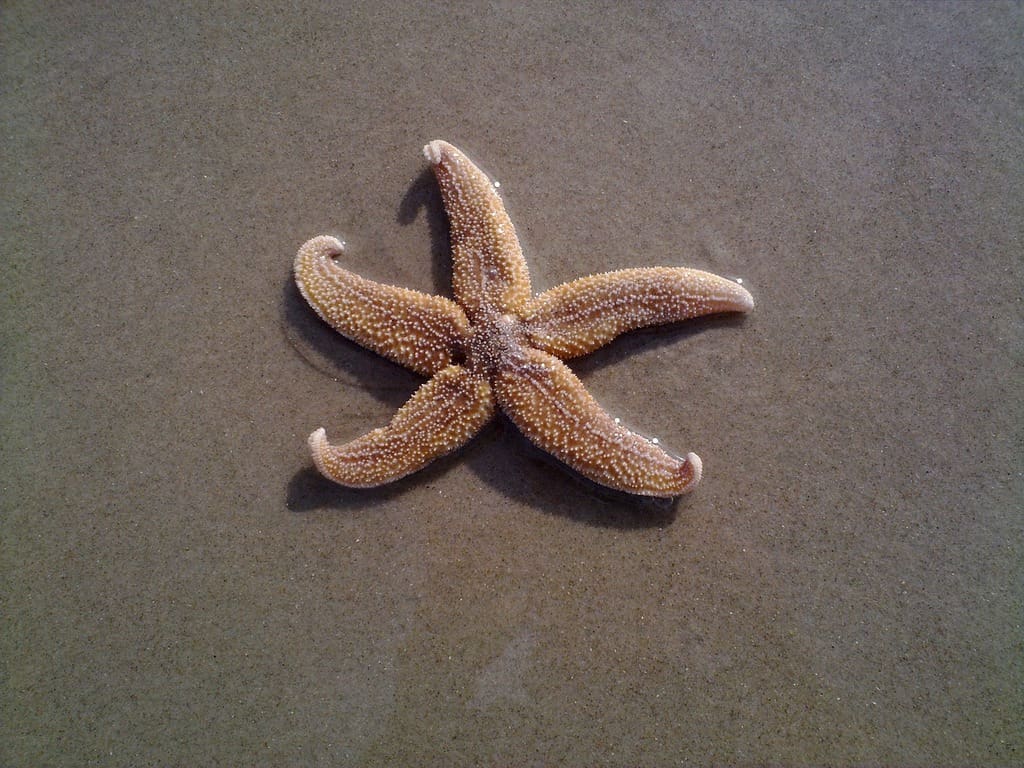
Asterias rubens
Latin name: Asterias rubens
Short name: Ast-r
Common name: Common Starfish | Red Starfish | Sea Star
Primary miasm: Sycotic Secondary miasm(s): Tubercular
Kingdom: Animals
Family: Echinodermata: Asteroidea
- Symptomatology
- Remedy Information
- Differentiation & Application
Asterias rubens is a marine echinoderm found in the North Atlantic and European coastal waters. The whole animal is macerated in alcohol to produce the tincture. It exerts a deep action on the cerebrospinal nervous system, particularly affecting the left side, and has a notable affinity for the female reproductive organs, breast tissue, and the vascular system. Historically, it was introduced into homeopathy for the treatment of epilepsy and has since been used for certain forms of paralysis, chorea, and scirrhous breast tumours [Hering].
No known use in orthodox medicine; in folklore, starfish were sometimes dried and powdered for external application in skin diseases, but this was largely symbolic and not scientifically validated.
Introduced by Dr. Tessier (Paris) in the mid-19th century, with toxicological observations and provings recorded by Hering, Allen, and Hughes.
- Nervous System: Paralysis, epilepsy, chorea, left-sided weakness [Hering, Allen].
- Female Breast & Reproductive Organs: Mastitis, scirrhus, irregular menses [Clarke].
- Vascular System: Varicose veins, congestions [Boericke].
- Left Side of the Body: Hemiplegia, left breast, left-sided headaches [Hering].
- Skin: Indurations, ulcers, chronic eruptions [Hughes].
- Gentle movement in paralysis (slight relief to rigidity) [Hering].
- Open air in certain headaches [Allen].
- Gentle pressure on affected breast in mastitis [Clarke].
- Cold, damp weather, which aggravates neuralgic pains [Hering].
- Left-sided pressure and lying on left side (breast and heart symptoms) [Clarke].
- Mental excitement preceding epileptic fits [Allen].
- Conium maculatum – Breast induration; Conium has more stony hardness and glandular origin, less nervous involvement.
- Lachesis mutus – Left-sided complaints, worse after sleep; Lachesis has more loquacity and general aggravation from heat.
- Cuprum metallicum – Epilepsy with violent cramps; Cuprum has more intense convulsions, less breast involvement.
- Silicea – Chronic indurations; Silicea has more suppuration tendency and chilliness.
- Complementary: Conium, Silicea, Cuprum.
- Antidotes: Camphora, Nux vomica.
- Inimical: None known.
- Follows well: After acute breast inflammation has subsided, to resolve induration.
Asterias rubens is a remedy for left-sided neurological and glandular affections, particularly in women. It unites two main spheres: the cerebrospinal system — with paralysis, epilepsy, chorea — and the mammary glands, with a specific action on induration and cancerous changes. The psychological tone is one of anticipatory dread, nervous weakness, and depression.
- Valuable in early stages of left breast scirrhus, especially before ulceration.
- Consider in left-sided hemiplegia post-stroke.
- Useful in epilepsy when aura begins in the left hand.
Mind:
- Anxiety before epileptic attacks
- Depression, tearful
- Confusion of mind, inability to concentrate
Head:
- Headache, left-sided
- Aura in epilepsy beginning in hand
Female:
- Breast, left, induration
- Pain, left breast, before menses
Extremities:
- Paralysis, left side
- Trembling of hands
Generalities:
- Left-sided complaints
- Worse damp cold weather
- Better gentle motion
Hering C. – Guiding Symptoms: detailed breast, epilepsy, and left-sided modalities.
Clarke J.H. – Dictionary: cancerous breast changes, nervous system.
Allen T.F. – Encyclopedia: proving and toxicological notes.
Hughes R. – Cyclopaedia: vascular and nervous pathology.
Boericke W. – Pocket Manual: clinical notes.
Lippe A. – Keynotes: breast indications.
Hale E.M. – New Remedies: neurological focus.
Farrington E.A. – Clinical Materia Medica: cancer and nervous system.
Nash E.B. – Leaders: clinical keynotes.
Kent J.T. – Lectures: comparative left-sided remedy analysis.
